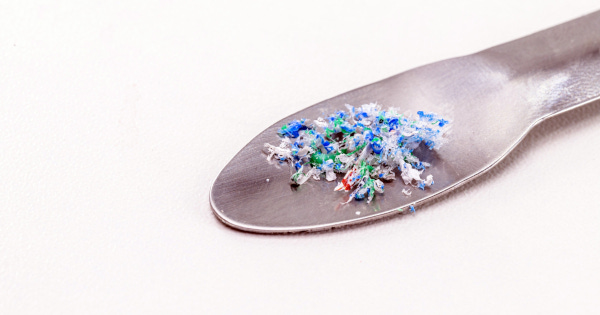Plastic on the Brain: Groundbreaking Study Detects Microplastics in Human Olfactory Bulbs for the First Time
Microplastics have been detected in human olfactory bulbs, suggesting a direct pathway to the brain
by GreenMedInfo Research Group
Tiny plastic particles are infiltrating our bodies at an alarming rate, with new research uncovering their presence in human brains, reproductive organs, and even our bloodstream.
Quick Summary:
Microplastics have been detected in human olfactory bulbs, suggesting a direct pathway to the brain
The presence of microplastics in human and canine testes raises concerns about impacts on male fertility
Individuals with microplastics in arterial plaque face 4.5 times higher risk of heart attack, stroke, or death
Simple solutions like boiling water can reduce microplastic exposure, but systemic changes are urgently needed
In recent years, the pervasive nature of plastic pollution has become increasingly apparent, with microplastics found in the remotest corners of our planet. However, new research is revealing an even more disturbing reality: these tiny plastic particles are not just in our environment, but have infiltrated our bodies in ways previously unimagined. From our brains to our reproductive organs and even our bloodstream, microplastics are turning up in human tissues with alarming frequency and potential health consequences.
Microplastics in the Human Brain
A groundbreaking study published in JAMA Network Open has provided the first evidence of microplastics in the human olfactory bulb, the part of the brain responsible for processing smell. This discovery raises serious concerns about the potential neurotoxic effects of these particles and the mechanisms by which they might reach brain tissues.
Researchers analyzed olfactory bulb tissues from 15 deceased individuals who had been residents of São Paulo, Brazil, for more than five years. Using advanced micro-Fourier transform infrared spectroscopy, they detected microplastics in the olfactory bulbs of 8 out of 15 individuals. A total of 16 synthetic polymer particles and fibers were identified, with polypropylene being the most common polymer detected.
The size of the microplastics ranged from 5.5 μm to 26.4 μm for particles, and the mean fiber length was 21.4 μm. These dimensions suggest that the particles are small enough to potentially cross the blood-brain barrier or reach the brain through the olfactory pathway.
Dr. Luís Fernando Amato-Lourenço, the study's lead author, emphasized the significance of these findings: "This case series provides evidence of MPs found in the human olfactory bulb, suggesting a potential pathway for the translocation of MPs to the brain. The findings underscore the need for further research on the health implications of MP exposure, particularly concerning neurotoxicity and the potential for MPs to bypass the blood-brain barrier."
Microplastics in Reproductive Organs
Another alarming study, published in the journal Toxicological Sciences, has revealed the presence of microplastics in both human and canine testes. This discovery raises significant concerns about the potential impact of these particles on male fertility and reproductive health.
The study, conducted by researchers from the University of New Mexico, analyzed 47 canine and 23 human testes for the presence of 12 types of microplastics. Using advanced sensitive pyrolysis-gas chromatography/mass spectrometry, the researchers found microplastics in all of the samples tested.
Both humans and canines exhibited relatively similar proportions of the major polymer types, with polyethylene (PE) being the most dominant. The mean total microplastic levels were 122.63 μg/g in dogs and 328.44 μg/g in humans.
The researchers also investigated potential associations with sperm count and the weights of the testis and epididymis in dogs. They found a negative correlation between specific polymers, such as polyvinyl chloride (PVC) and polyethylene terephthalate (PET), and the normalized weight of the testis. This suggests that exposure to these types of microplastics may have an adverse effect on testicular development and function.
Dr. Xiaozhong Yu, one of the study's authors, commented on the implications of their findings: "Our study is the first to quantify and characterize microplastics in human testes, and the results suggest that microplastics may have a negative impact on male fertility. More research is needed to determine the full extent of the impact of microplastics on male fertility and overall health."
Microplastics and Cardiovascular Risk
Perhaps the most alarming recent discovery comes from a study published in the New England Journal of Medicine, which found a strong association between the presence of microplastics in arterial plaque and increased risk of cardiovascular events.
The study, conducted by Italian researchers, involved 257 patients who underwent surgery to remove built-up plaque from their carotid arteries. Using sophisticated chemical analysis techniques and high-resolution electron microscopy, the scientists analyzed the excised plaque specimens for the presence of microplastics and nanoplastics (MNPs).
The results were shocking: 58.4% of the patients had measurable amounts of polyethylene in their arterial plaque, with an average concentration of 21.7 micrograms per milligram of plaque tissue. Additionally, 12.1% of patients also had detectable levels of polyvinyl chloride.
But the most concerning finding came from following the patients' health outcomes over an average of nearly 3 years after their surgery. The researchers found that those patients with MNPs detected in their excised plaque had a staggering 4.53 times higher risk of experiencing a major adverse cardiovascular event - defined as a heart attack, stroke, or death from any cause - compared to patients without detectable MNPs in their plaque.
Dr. Philip Landrigan, who wrote an accompanying editorial, emphasized the urgency of addressing this issue: "Inaction is no longer an option...We need to encourage our patients to reduce their use of plastics, especially unnecessary single-use items."
Potential Solutions and Mitigation Strategies
While the accumulating evidence paints a grim picture of the pervasiveness and potential health impacts of microplastics, researchers and health experts are also exploring potential solutions and mitigation strategies.
1. Water Purification
A recent study published in Environmental Science & Technology Letters has revealed a surprisingly simple method for reducing microplastic exposure through drinking water. The research, conducted by a team led by Professor Eddy Y. Zeng of Jinan University, found that simply boiling tap water can eliminate up to 90% of nano- and micro-plastics.
The researchers discovered that heating causes minerals in hard water to bind to nano- and microplastics (NMPs), encapsulating them in calcium carbonate precipitates that form limescale. These plastic-laden particles can then be easily filtered out through everyday methods like pouring the boiled water through a strainer or scrubbing the boiled kettle.
2. Activated Charcoal
Preliminary research indicates that activated charcoal may adsorb and remove micro- and nano-plastics from the body. Some companies are now producing ozonated versions with enhanced micropore numbers, potentially increasing their ability to bind to and neutralize these plastics.
3. Plastic-Free Product Choices
Opting for products that don't contribute to microplastic pollution, such as loose-leaf teas instead of bagged varieties, can help reduce individual exposure and environmental impact.
4. Sweating for Detoxification
Some researchers suggest that sauna- or exercise-induced sweating may enhance bodily detoxification of microplastics, though more research is needed to confirm this hypothesis.
The Need for Systemic Change
While individual actions can help mitigate personal exposure to microplastics, the scale of the problem demands systemic changes. Dr. Landrigan argues that addressing the harms of plastic pollution must be a key part of the urgent transition away from petroleum-based products.
Policy measures such as bans on single-use plastics, improved waste management systems, and investment in biodegradable alternatives are crucial steps in reducing the overall burden of microplastics in our environment and, by extension, our bodies.
Conclusion
The recent discoveries of microplastics in human brains, reproductive organs, and arterial plaque paint a disturbing picture of the extent to which these synthetic particles have infiltrated our bodies. The potential health implications, from neurotoxicity to reduced fertility and increased cardiovascular risk, are deeply concerning and demand urgent attention from the scientific community, policymakers, and the public.
While simple measures like boiling water and choosing plastic-free products can help reduce individual exposure, the ubiquity of microplastics in our environment calls for sweeping changes in how we produce, use, and dispose of plastic materials. As we continue to uncover the full extent of microplastic pollution in human tissues, it's clear that this invisible invasion represents one of the most pressing public health challenges of our time.
The path forward will require a combination of further research, innovative solutions, and collective action to stem the tide of plastic pollution and protect human health for generations to come. As individuals, we must remain vigilant about our plastic use and exposure, while advocating for broader systemic changes to address this global crisis
In the Art of Liberty Foundation’s book: “Government” – The Biggest Scam in History… Exposed! We break down how “Government” is best thought of as a technique for robbing and controlling populations. The book also exposes how an inter-generational organized crime system has been controlling the information the population receives about the legitimacy, necessity and desirability about “government” using mandatory “government” schools, scouting, Explorers, JROTC, ROTC, police and military training, monopoly media, propaganda woven into Hollywood films and television shows, and the algorithmic censorship of the internet.
The indoctrination and propaganda have been so successful that many people have never been exposed to the alternative to top-down “government” control.
They falsely believe that voting in rigged elections for the lesser evil is their only choice.
On November 1st-3rd, The Art of Liberty Foundation will be hosting Liberty on the Rocks – Sedona – The Voluntaryism Conference.
Discover the option that is NEVER offered or discussed by the MainStreamMedia or the MainStream Alternative Media: REAL FREEDOM!
We don’t really need “Government!”
All the legitimate services provided by monopoly “government” would be better provided by the free market, mutual aid societies, armed protective service companies, arbitration providers, insurance companies, and genuine charities.
Without the government’s mandatory inflationary money and confiscatory taxation, the economy would prosper and the population would be much wealthier and better able to help the poor, needy and disadvantaged.
Come join some of the country’s leading economists, legal experts and political philosophers discuss how the world could have more harmony and prosperity without “government”
Sedona.ArtOfLiberty.org - In-Person or Virtual – November 1st-3rd
Go Paid on Substack @ the $50 a Year Level and get a Free Ticket to the Liberty on the Rocks virtual conference and a free softcover copy of Etienne’s new book: Voluntaryism – How the Only “ISM” Fair for Everyone Leads to Harmony, Prosperity and Good Karma for All when released in November.
Go Paid at the $250 a Year Founding Member Level and get a free in-person ticket to Liberty on the Rocks in Sedona and a signed copy of the “Swiss Flip” version of Voluntaryism AND “Government” when released in November.








It's unbelievable that nothing has been done about this when it's been known for at least 10 years. This affects everyone. But it is staggering the lack of imagination in how to fix it when it is ultra easy. We need to incentivize new actions, new habits. What is the point of banning it when that just takes away more of our freedom? We need to learn to be responsible individuals and not just wait to be foreced. So we need to reward those who do the right thing. If you don't own a car, if you don't buy plastic water bottles, if you don't buy groceries with plastic packaging - you should be rewarded. Extra packing should be returned to the store and dumped in their lobby. This is EVERYBODY'S BUSINESS. Why should those who give not a whit to their pollution footprint, get the benefits of convenience as everything is geared to DO THE WRONG THING and it's actually more inconvenient to do the right thing. Doing the right thing has garnerd no rewards, you're just expected to do the right thing. And by thinking this way it only serves the lazy, non-thinkers. We know that government is not going to do anything, so pretend they don't even exist. Consider them like locust swarms or pests and simply avoid government like the plague. This is a good time to learn how to do things "OUR WAY". We can start our own rewards systems, why wait for daddy government to do it. If government cared they would have been onto it years ago. Don't just think it will happen/ By the time they get off their posterior, more plastics would have come into the wastestream and more sickeness, more dementia.
It actually does start and end with you and me, but we need incentives to make it a big draw. We need to get points for doing the right thing.
So many things are done in a worse manner as time goes on- now they're shrink wrapping organic vegetables and they sell organic eggs in plastic containers. Can someone please tell me who's great idea this is?
I also see dog walkers collect their dog's poop in plastic bags. Oh great - add that to the wastestream. When what would be a hundred times better would be to carry a trowel and just cover the little patty with dirt. Then you get NO WASTE and the poop becomes fertilizer. That's where it's SUPPOSED to go - in the soil. Is that just too obvious that nobody can see? If you don't pick up your doggie doos with plastic and cover it over like I do, you get looked at as though you just kidnapped a baby, when the whole time it is the sloppy joes who think they are being "clean" when really they are poisoning themselves and all of us.